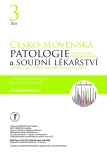Aspects of forensic entomology in forensic medicine
Authors:
Mikuláš Ubomír 1,2; Kutišová Dana 1,2; Šikuta Ján 1,2; Kuruc Roman 1,2; Šidlo Jozef 1,2
Authors‘ workplace:
Súdnolekárske pracovisko, Úrad pre dohľad nad zdravotnou starostlivosťou, Bratislava, Slovenská republika
1; Ústav súdneho lekárstva, Lekárska fakulta, Univerzita Komenského v Bratislave, Bratislava, Slovenská republika
2
Published in:
Soud Lék., 66, 2021, No. 3, p. 39-42
Category:
Review
Overview
ntomology, as a vast scientific discipline of zoology, deals with the study of insects, which are an integral part of the ecosystem of our planet and are closely linked to the activity and life cycle of all organisms, including humans. As a result of this natural connection, insects often become a direct “living witness” of a crime and thus an invaluable part of the evidence in a comprehensive forensic investigation, which in such cases necessarily includes a specialized field of science - forensic entomology. The goals of forensic entomology include comprehensive analysis of entomological evidence material and the use of knowledge about insects and other invertebrates for the purpose of investigating and verifying evidence in civil and criminal law. In practice, forensic entomology falls into several categories, including the issue of food pests in industry or agriculture, human and animal parasitology (especially myiasis) and very often the field of criminology and forensic medicine, where the results are mainly applied to determine the length of post mortem interval (PMI), evidence of manipulation of the corpse, or other forensic facts that results from entomological analysis. The conclusions of the entomology study are in many cases an invaluable part of the amount of information that leads to the answer of key questions in complex forensic evidence, especially in the group of serious crimes.
Keywords:
forensic entomology – Insects – forensic medicine – criminalistics – post mortem interval
Sources
1. Gennard D. Forensic Entomology, An introduction. Chichester : John Wiley & Sons Ltd; 2007: 244.
2. Šuláková H. Forenzní entomologie - když smrt je začátek. Praha: Nakladatelství Academia, 2014, Živa 5/2014: 250-256.
3. Gennard D. Forensic Entomology, An introduction, Second edition. Chichester: John Wiley & Sons, Ltd; 2012: 272.
4. Jason HB, James LC. Forensic entomology, The utility of arthropods in legal investigations. Boca Raton: CRC Press; 2001: 440.
5. Jason HB, James LC. Forensic Entomology, The Utility of Arthropods in Legal Investigations, Second Edition. Boca Raton: CRC Press; 2010: 705.
6. Gillott C. Entomology, Third edition. Dordrecht: Springer; 2005: 831.
7. Ladislav D. Možnosti využití entomologie v kriminalistice. Praha: Publication Kriminalistický ústav, 1990.
Labels
Anatomical pathology Forensic medical examiner ToxicologyArticle was published in
Forensic Medicine

2021 Issue 3
Most read in this issue
- Aspects of forensic entomology in forensic medicine
- The extension, importance and function of eponymous terms in forensic medicine
- First Polish case of fatal single-substance poisoning with cyclopropylfentanyl, a new synthetic opioid
- MUDr. Josef Pleskot
